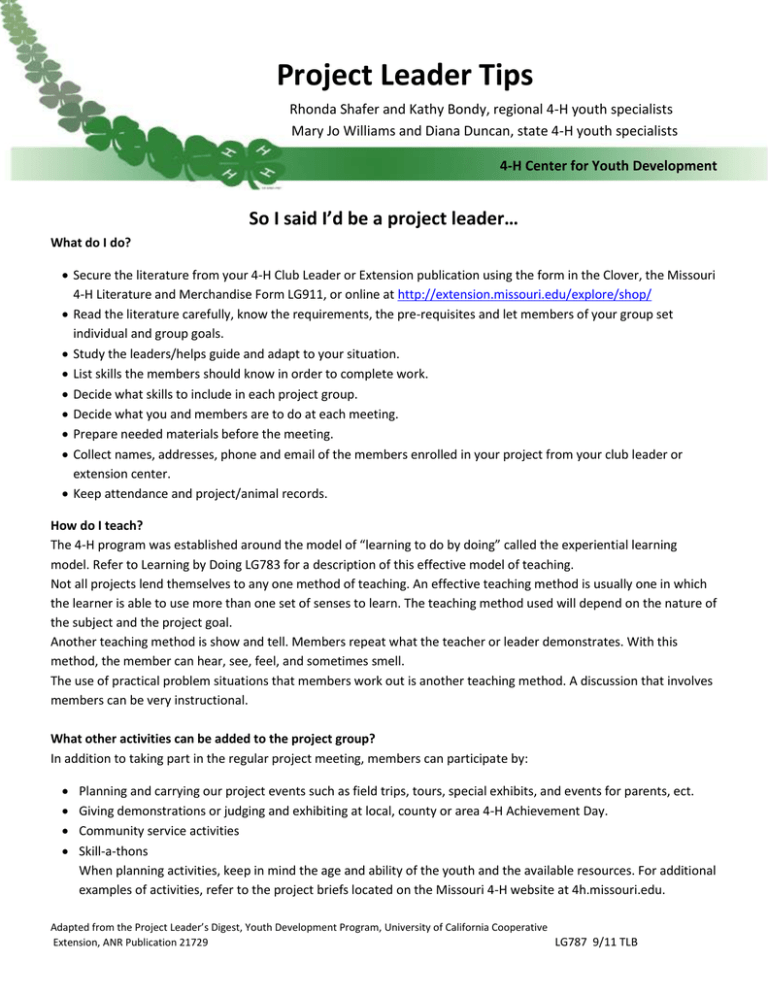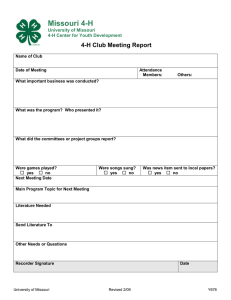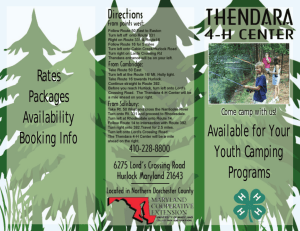Project Leader Tips
advertisement

Project Leader Tips Rhonda Shafer and Kathy Bondy, regional 4-H youth specialists Mary Jo Williams and Diana Duncan, state 4-H youth specialists 4-H Center for Youth Development So I said I’d be a project leader… What do I do? Secure the literature from your 4-H Club Leader or Extension publication using the form in the Clover, the Missouri 4-H Literature and Merchandise Form LG911, or online at http://extension.missouri.edu/explore/shop/ Read the literature carefully, know the requirements, the pre-requisites and let members of your group set individual and group goals. Study the leaders/helps guide and adapt to your situation. List skills the members should know in order to complete work. Decide what skills to include in each project group. Decide what you and members are to do at each meeting. Prepare needed materials before the meeting. Collect names, addresses, phone and email of the members enrolled in your project from your club leader or extension center. Keep attendance and project/animal records. How do I teach? The 4-H program was established around the model of “learning to do by doing” called the experiential learning model. Refer to Learning by Doing LG783 for a description of this effective model of teaching. Not all projects lend themselves to any one method of teaching. An effective teaching method is usually one in which the learner is able to use more than one set of senses to learn. The teaching method used will depend on the nature of the subject and the project goal. Another teaching method is show and tell. Members repeat what the teacher or leader demonstrates. With this method, the member can hear, see, feel, and sometimes smell. The use of practical problem situations that members work out is another teaching method. A discussion that involves members can be very instructional. What other activities can be added to the project group? In addition to taking part in the regular project meeting, members can participate by: Planning and carrying our project events such as field trips, tours, special exhibits, and events for parents, ect. Giving demonstrations or judging and exhibiting at local, county or area 4-H Achievement Day. Community service activities Skill-a-thons When planning activities, keep in mind the age and ability of the youth and the available resources. For additional examples of activities, refer to the project briefs located on the Missouri 4-H website at 4h.missouri.edu. Adapted from the Project Leader’s Digest, Youth Development Program, University of California Cooperative Extension, ANR Publication 21729 LG787 9/11 TLB Working in the Partnership with Youth Leaders Youth and adult partnerships in 4-H provide an opportunity for youth and adults to share responsibility and ideas and to develop leadership skills together. Youth leaders are involved in planning, teaching and leading projects, activities and events at all levels of the 4-H Youth Development Program. Successful youth-adult partnerships include: Build relationships and cooperative environment. Learn about each other before you start the project. This builds trust. Understand differences. Learn from one another what each of you needs and expects from the other(s). Everyone can contribute to the project. Understand that each person brings gifts/talents/resources to the partnership. Know your goals and focus on the ones you have in common. Youth need to be involved with decisions that affect them and adults need to understand why this is important? Find a balance of power and find importance in working together. Try to maintain an equal number of youth and adults. Ensure that youth are decision-makers, not just participants or observers. Reveal skills and attitudes that will cultivate a successful partnership. Youth are capable of significant decision-making. Show genuine concern for issues addressed in the project. The issues should be real and relevant to youth. Recognize and bring attention to the feeling of accomplishment. Acknowledge every person’s contribution as a part of the team. Youth and adults can work together to develop common goals. We recommend starting with the development of a job description to clearly define each person’s responsibilities and a plan of work that identifies the expectations of the youth and adults. Planning an activity on paper will help to identify all the tasks involved. An adult project leader must be willing to share the project responsibilities and leadership role before he or she asks a youth to serve as an assistant. Adults and youth both should agree to the following. Adults 1. Recognize youth as equals in making decision and accepting responsibilities. 2. Model good communication with youth. 3. Encourage and support youth on a continuing basis throughout planning, implementation and evaluation of the activity. 4. Understand that mistakes are opportunities to learn. 5. Ask for assistance when needed. Teens 1. 2. 3. 4. 5. Get along with younger 4-H members, peer group and adults. Be sincere in helping other and working with groups. Plan ahead and complete activities. Be aware of abilities and limitations. Ask for assistance when needed. Adapted from the Project Leader’s Digest, Youth Development Program, University of California Cooperative Extension, ANR Publication 21729 LG787 9/11 TLB 6. Share decision making and responsibilities with adults. Adapted from the Project Leader’s Digest, Youth Development Program, University of California Cooperative Extension, ANR Publication 21729 LG787 9/11 TLB


